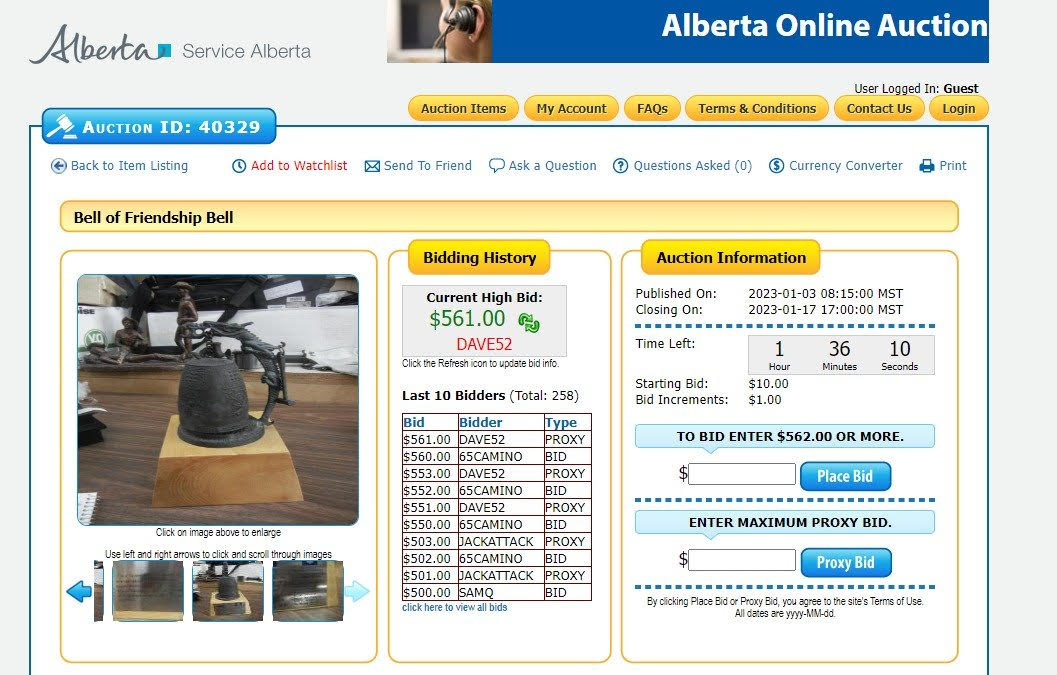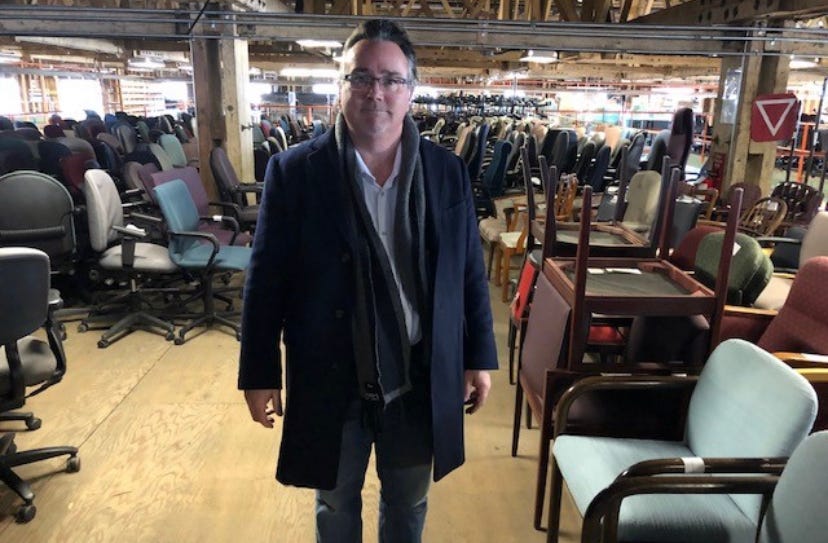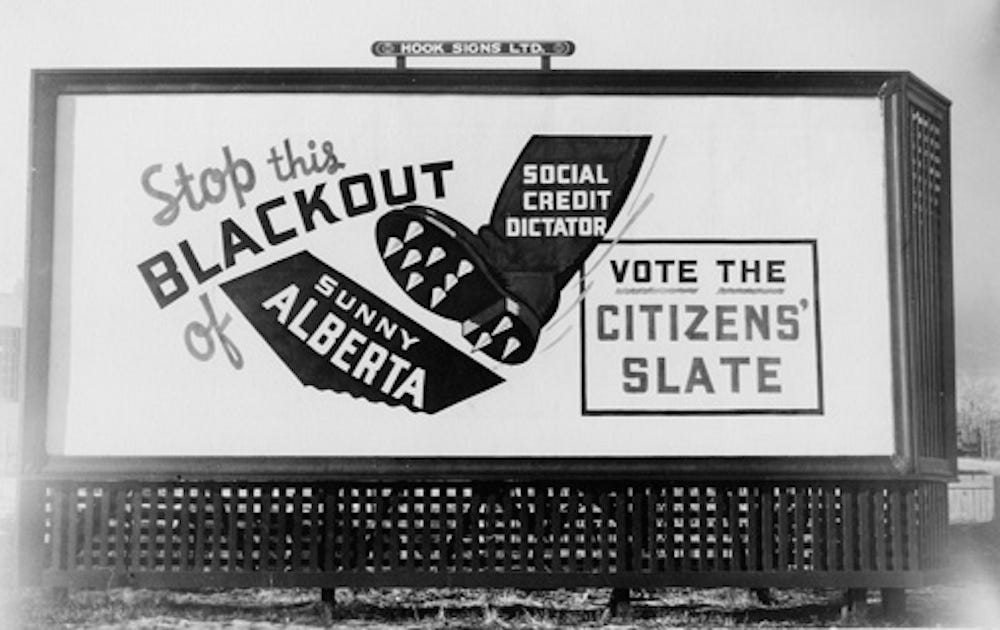Smaller parties will have a hard time in Alberta's 2023 election
The most successful smaller group might be Take Back Alberta, which continues to expand its influence over the UCP.
I’m Dave Cournoyer and this is the Daveberta Substack.
I’d like to extend a sincere heartfelt thank you to everyone who has signed up to the Daveberta Substack. And a special thanks goes to the growing number of paid subscribers who have signed up to support what we do on the Daveberta Substack and Daveberta Podcast (listen to our latest episode with former Calgary mayor Naheed Nenshi).
If you like what you read on here, please consider supporting Daveberta with a monthly ($5/month) or annual ($50/year or $4.17/month) subscription. Paid subscribers will have access to the podcast and some election extras we will be sharing soon.
Thank you.
TL;DR
If you don’t have time to read today’s column right away, here are some of my main points:
The Alberta election looks like a tight race between the UCP and NDP, so there’s not much room for the smaller political parties.
The Alberta Party lost all its MLAs in 2019 and leader Barry Morishita placed third in the 2022 Brooks-Medicine Hat by-election, probably hurting chances the party had at making many gains in 2023.
The Liberal Party formed Official Opposition from 1993 to 2012 but is now a shell of its former self and is unlikely to have much of a presence in this election.
Take Back Alberta is a growing influence inside the UCP. Supporters of the right-wing group control half of the UCP provincial executive and are expanding their influence in UCP local constituency associations and candidate nominations. TBA could also support Independent candidates outside the UCP.
It looks like the UCP and NDP are set to win most or all of the seats in this election but anyone who has paid attention to provincial politics over the past decade knows that sometimes the most unlikely of outcomes are what happens in Alberta.
Today’s column
Smaller parties will have a hard time in Alberta's 2023 election
With 68 days left until Alberta’s next provincial election, all indicators suggest it is a two party race between the United Conservative Party led by Premier Danielle Smith and the NDP led by former premier Rachel Notley.
The two main political parties are neck and neck in province-wide polls and narrowly exchanging leads in Calgary, where many political watchers believe the most seats could change hands on Election Day.
The UCP and NDP are taking up most of the political oxygen and fundraising money, but there are a handful of smaller parties that would like to make a splash (but more likely a ripple) when voters go to the polls on May 29, 2023.
Those smaller parties were the topic of a recent episode of CBC’s West of Centre Podcast, which I had the pleasure of joining.
The smaller parties
The Alberta Party is probably the most prominent of the smaller parties, having had 3 MLAs until losing its representation in the Legislature in 2019. A distant third place finish by leader and former Brooks mayor Barry Morishita in last November’s by-election in Brooks-Medicine Hat didn’t provide any momentum for the party going into 2023.
The Alberta Party is putting some effort into Kerry Cundal’s campaign in Calgary-Elbow, a riding held by former party leader Greg Clark from 2015 to 2019. But UCP candidate Chris Davis and the NDP’s Samir Kayande are serious contenders in this potential swing riding.
The Liberal Party is deep in the political wilderness. The party formed the Official Opposition from 1993 to 2012 but now has no MLAs and mostly exists on paper with a handful of loyal supporters left carrying the banner.
The Green Party has nominated 27 candidates so far and appear to be mounting an effort to be an ecological-focused alternative to the NDP.
Alberta’s biggest cottage industry
Albertans might not hear much about the Alberta Advantage Party, the Buffalo Party, and the Reform Party but there are other products of Alberta’s cottage industry of small right-wing political parties that could get some attention this spring.
Since taking over the leadership of The Independence Party of Alberta, Pastor Artur Pawlowski has turned the separatist party into a vehicle to campaign against COVID-19 public health mitigation measures and promote a wide range of conspiracy theories that came out of the pandemic. He’s also been hosting events with former Trump medical advisor Dr. Paul Alexander and British Columbia Christian Heritage Party former leader Laura-Lynn Tyler Thompson.
While it experienced a brief surge in the polls in 2021, the Wildrose Independence Party has essentially collapsed following a series of internal political battles and leadership challenges. Ousted party leader Paul Hinman is now trying to start a new political party called the Wildrose Loyalty Coalition.
But the small political party with the most money might not have many candidates on the ballot.
The Pro-Life Alberta Political Association raised $323,990 in 2022 but operates as a political action committee with the ability to issue generous tax receipts for political donations. The party was formed in 2017 after a group of of anti-abortion activists took over and renamed the old Social Credit Party. The party doesn’t appear to show any interest in running candidates in the upcoming election.
It’s not easy being small
Being the leader of a small party with no seats in the Legislature is a tough job.
Usually the smaller parties don’t have a lot of money, so unless the leader is independently wealthy, it is typically not a great way to feed your family and pay the mortgage.
Oilman-turned-Liberal Party leader Nick Taylor was able to wander for so long in the political wilderness because he had made so much money in the oil business. Taylor self-financed the Liberals for much of his time as party leader from 1974 until he was finally elected to the Legislature in 1986.
Not having an MLA in the Legislature also cuts down on the media attention a party receives on a regular basis. And without an MLA, the party’s leader might not secure a spot in a televised leaders debate during an election.
While there are no steadfast rules governing which parties are represented in televised leaders debates in Alberta elections, typically only parties with elected MLAs are invited.
But there are a few exceptions.
Freedom Conservative Party leader Derek Fildebrandt wasn’t invited to join the debate in 2019, despite being the MLA for Strathmore-Brooks (he was UCP MLA before a series of events led to his joining the short-lived FCP). And in 1997, NDP leader Pam Barrett and Social Credit leader Randy Thorsteinson were given spots in the debate despite both parties being shut out in the previous election.
Independents could make a break
The only non-UCP and non-NDP breakthroughs in this election might end up coming from candidates running under no party banner at all.
Cypress-Medicine Hat MLA Drew Barnes hasn’t announced his plans but he could run for re-election as an Independent candidate.
Barnes was kicked out of the UCP Caucus in 2021 for being a thorn in former premier Jason Kenney’s side and a loud critic of COVID-19 public health mitigation measures. His three terms as MLA and frequent media coverage might be enough to get elected to a fourth term as an Independent.
A similar argument could be made for Tim Hoven, a farmer and former county councillor who recently announced plans to run as an Independent candidate against UCP MLA Jason Nixon in Rimbey-Rocky Mountain House-Sundre. Riding a wave of protests against COVID mitigation measures, Hoven tried to challenge Nixon for the UCP nomination but was disqualified after some controversial social media posts were discovered. Now he’s back.
But even Independent candidates have an uphill battle to get elected, and it doesn’t happen very often. The last time an Independent candidate was elected to the Alberta Legislature was in 1982 when two former Social Credit MLAs, Walt Buck and Raymond Speaker, were re-elected as Independents.
Independents usually don’t have a party-like organization or fundraising machine behind them (an exception being the Independent Citizen’s Association in the 1940 election), but in this election Barnes and Hoven could have the support of political group that has taken the UCP by storm: Take Back Alberta.
Take Back Alberta
Take Back Alberta is not an actual political party, it’s a political action committee, but it’s having a big influence on the upcoming election.
Evolving out of opposition to COVID-19 mitigation measures and support for the blockades at the Coutts border crossing, the Take Back Alberta PAC has had huge success securing elected positions and candidate nominations in the United Conservative Party.
Led by conservative activists including political organizer David Parker and Fort Macleod town councillor Marco Van Huigenbos, the group played a big role in defeating former premier Jason Kenney in the 2022 leadership review and supporting Danielle Smith in the leadership race that followed.
TBA mobilized hundreds of its supporters to show up and vote at the UCP annual general meeting last year, resulting in its endorsed candidates now controlling half the party’s provincial executive board. Parker continues to tour the province holding town hall meetings promoting TBA and the group is said to be preparing to take over the remainder of the UCP board at the party’s next AGM later this year.
While their efforts might sound like insider baseball to some Albertans, TBA’s growing influence over the governing UCP will have real implications for the next few years in Alberta, especially if Smith’s party is re-elected in May.
Political change can come from where you least expect it
It doesn’t look like it will happen in this election but smaller political parties have historically been a catalyst for electoral change in Alberta.
The United Farmers of Alberta swept into power in 1921 after only previously electing one MLA in a by-election two years earlier.
The Social Credit Party had never elected any MLAs before it cruised to victory in 1935.
The Progressive Conservatives were a well-established federal presence in Alberta but had lingered in the opposition benches before Peter Lougheed led the party to win in 1971.
The Wildrose Party led by Danielle Smith nearly formed government in 2012.
And nobody expected Rachel Notley’s Edmonton-based NDP would generate an Orange Wave that would crash across Alberta in 2015.
Right now it’s likely the UCP and NDP will hold all or most of the seats in the Legislative Assembly when the votes are counted in May. But anyone who has paid attention to provincial politics over the past decade will know that sometimes the most unlikely of outcomes are what happens in Alberta.
One more thing…
Government almost accidentally auctions off Korean Bell of Friendship

If you are in the market for used office furniture or old electronics, then the Alberta Government’s online auction website is probably for you. Sometimes you might also find an old piano, intriguing piece of art, mobile trailer or heavily-used ATV, but a few months ago something very unique was put on the government’s auction block: a Bell of Friendship.
This particular Bell of Friendship was gifted to the Government of Alberta in 1981 by the then-Governor of Kangwon-do (known more commonly as Gangwon), South Korea.
Gangwon has had a sister province trade and investment relationship with Alberta since 1974 (it began with a joint beef ranching demonstration project). The 30th anniversary of the sisterhood was celebrated in 2004 when the Korean province constructed a beautiful pavilion on the grounds of Government House in Edmonton.

The appearance of the diplomatic percussion instrument caught the attention of some folks online, especially after it appeared to have been auctioned off for $2.553.00 on January 17, 2023.
I was surprised to see a gift like this end up on the auction block, so I reached out to the government for comment.
According to Jared Gustafson, the press secretary for Minister of Service Alberta Dale Nally, the Bell of Friendship was designated surplus by the former Ministry of Jobs, Economy and Innovation on August 25, 2022 and put up for sale by Alberta Surplus Sales on January 3, 2023.
But, before the online buyer, who used the username QRAD2019, was able to pick up their newly purchased Bell of Friendship, someone in government noticed and the sale was reversed.
“It is a regrettable mistake that this item was designated as surplus and the sale of the Bell of Friendship was reversed at the request of the Ministry of Forestry, Parks and Tourism on January 18, 2023,” Gustafson wrote in an email statement.

“Surplus Sales already has well-established safeguards in place to prevent this sort of thing from happening, but in light of this incident, several improvements have been made to existing safeguards and training materials,” Gustafson wrote.
I am told that when official state gifts like this are presented to government officials, they are usually given to the government’s International Relations division for safe keeping and typically not auctioned off.



Last election, the AB Party and the ALP took 11.5% of the total vote. If, under the pressure of a tight 2-party race, that total falls to, say, 5%, who should benefit more? Have you seen any polls that considered that?
Conversely, in Calgary Elbow, if the AB candidate takes, say, the 15% total that Morashita did, who benefits more than the other between the UCP or the NDP?
Finally, if Barnes does run in CMH, which of his opponents will benefit and will it matter?